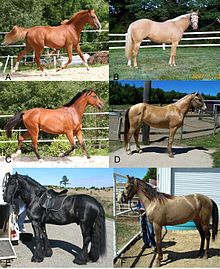Dilution gene

A dilution gene is any one of a number of genes that act to create a lighter coat color in living creatures. There are many examples of such genes:
General
Diluted coat colors have melanocytes, but vary from darker colors due to the concentration or type of these pigment-producing cells, not their absence. Pigment dilution, sometimes referred to as hypomelanism, has been called leucism, albinism (perfect, impartial, or dilute), ghosting, paling, and isabellinism.[1]
- Albinism describes a condition where pigment cells synthesize little or no pigment
- Leucism describes a condition that creates loss of pigment cells
Cats
- Cat coat genetics discusses many dilution genes in cats
Horses
- Equine coat color genetics discusses color genes in horses, including a brief description of dilution genes
- Equine coat color describes various colors in horses
- Cream gene, describes the process for horses by which the cremello, perlino, smoky cream double-dilute colors are created as well as the buckskin, palomino and smoky black single dilute colors.
- Dun gene describes another common dilution gene in horses
- Champagne gene, describes a different and rarer dilution gene in horses that also creates cream coloring, pale skin with mottling and light-colored eyes.
- Pearl gene, also called the "Barlink factor", is a recessive gene. One copy of the allele has no effect on the coat color of black, bay or chestnut horses. Two copies on a chestnut horse produce a pale, uniform apricot color of body hair, mane and tail as well as pale skin. It also interacts with Cream dilution to produce "pseudo-double" Cream dilutes with pale skin and blue or green eyes.
- Silver dapple gene, describes a dilution gene that works in a unique manner, lighting the mane and tail of a horse to a greater degree than the body color (opposite of most dilution genes, which act more strongly on the body color)
- White (horse) describes several unique genetic processes that create truly white, not diluted, color in horses.
- Gray (horse) explains the process of the gray gene, which lightens the coat over time, but is not a dilution gene.
- Mushroom (horse) describes an unknown and unmapped theorized dilution gene dilutes red pigment in body color to a pale beige color.
References
- ^ Davis, Jeff N. (September–October 2007). "Color Abnormalities in Birds". Birding. 39 (5). American Birding Association.
See also
- wikispecies:Felis sylvestris catus (cat)
- wikispecies:Equus caballus (horse)

